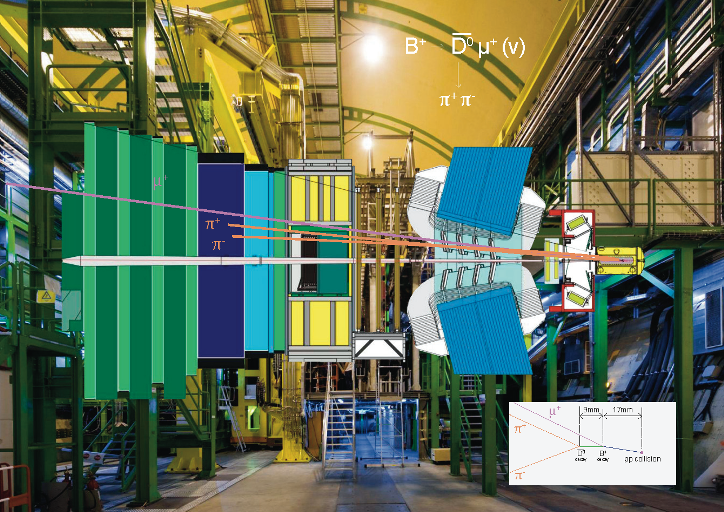
click the image for higher resolution
.
An interesting event in which a beauty B+ particle decay into a charm particle D0, μ+ and neutrino ν is shown. The μ+ is seen as a purple track traversing the whole detector while the neutrino is not observed in the detector. The D0 decays in turn into two pions, π+ and π–, seen as a pair of orange tracks traversing the detector and absorbed in the calorimeters inside the detector. The lower right image shows the zoom around the proton-proton collision point. The μ+ purple track originates from the B+ decay point located 17 mm from the proton-proton collision. The π+ and π– tracks originate from the D0 decay point located 9 mm from the B+ decay point.
D0 particles are also produced directly at the pp collision points. These events are used to measure the D0 lifetime in the masterclasses exercise. The event kind in which D0 particles are produced in the beauty particle decays, as shown above, represent so called background events in the D0 lifetime measurement. The contribution of these background events is reduced by using cuts (event selection) proposed in the masterclasses exercise.
.
More details:
(1) The particle tracks overlay the layout of LHCb detector showing the location of different detector elements in the LHCb underground cavern. Read more about the LHCb detector here and see photos of the LHCb cavern here. You can make the virtual tour of LHCb detector following links from the LHCb public page.
(2) There are many other particle tracks produced in the pp collision in addition to the ones involved in the B+ decays. They are shown in the different display of the same event here.
(3) The overlay above D0 indicates that the D0 charm particle is an antimatter particle. Similar events where matter charm particles D0 are produced instead of the D0 are identified by the presence of a μ– in the event instead of μ+. Using these two types of events LHCb physicists study the difference between the properties of matter and antimatter by measuring the different rates of D0and D0 decays into π+ and π– pairs.
(4) Particle quark composition: The B+ particle is composed of a beauty antiquark (b) bound with an up quark (u). The D0 particle is composed of a charm antiquark (c) bound with an up quark (u).
